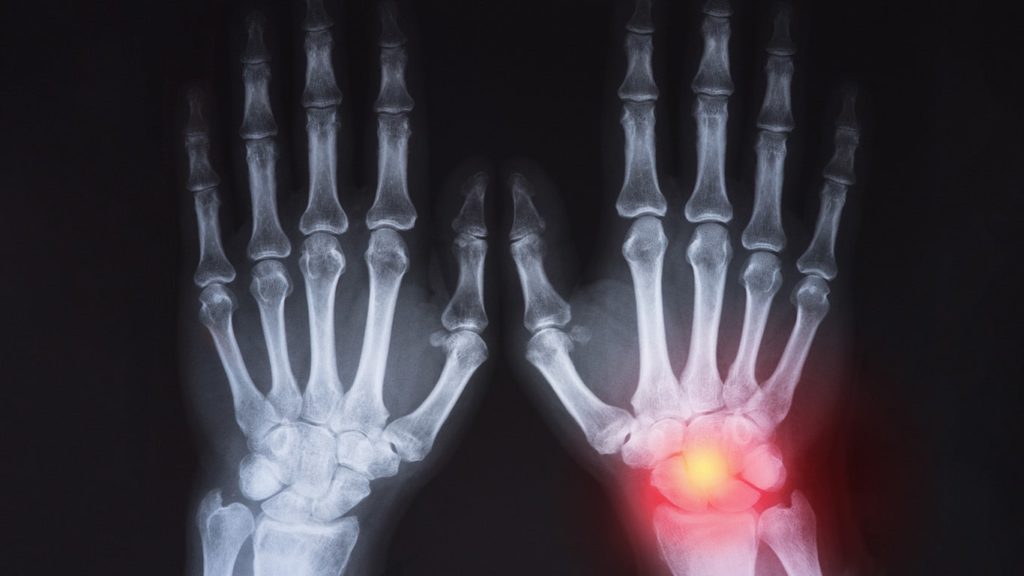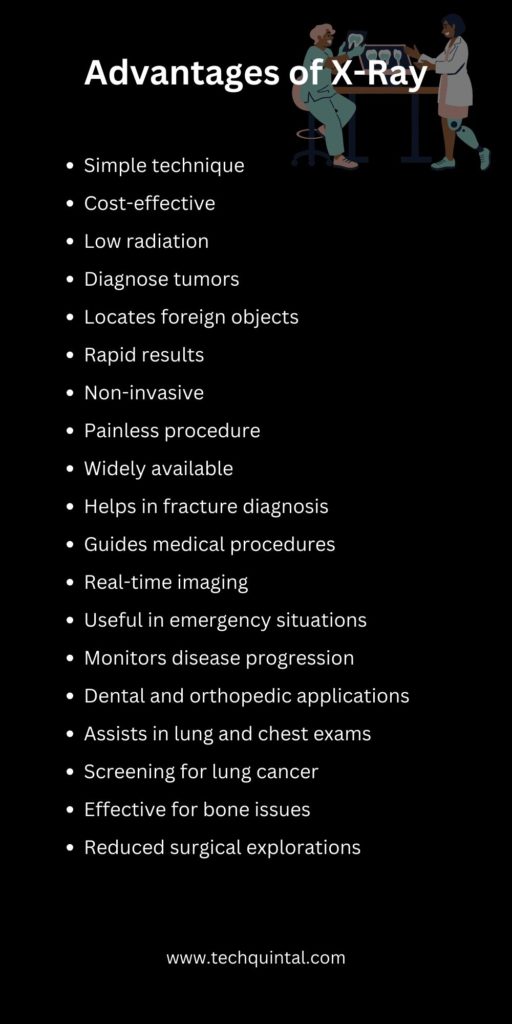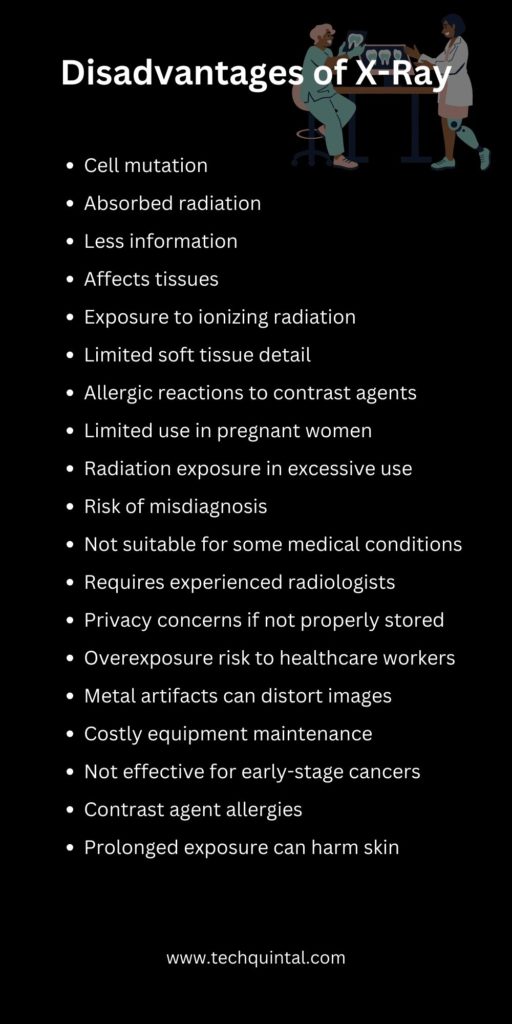
German Physicist Wilhelm Conrad Roentgen discovered X-ray in the year 1895. It was actually an accidental discovery. He was testing cathode rays when he found X-Rays passing through substances. In no time, he discovered that these rays can also pass through human tissues, showing images of the internal body. The only option available at that time to diagnose problems was to cut the body part. Thanks to the discovery of the X-Rays, we finally found a way to look inside the body without making an incision. It has been one of the most notable discoveries of all time.
Today, with X-Ray technology, we can diagnose all types of cancer, broken bones, and other problems. We have already covered different types of X-Rays. In this discussion, let’s take a deep look into its advantages and disadvantages.
What is X-Ray? A Simple Explanation
An X-ray is a special kind of picture that lets doctors see inside your body. It’s like having superpowers, seeing through skin and bones! Imagine you’re looking for a toy hidden inside a box; an X-ray helps the doctor find things like broken bones or other problems inside your body. The X-ray machine sends out tiny particles called X-ray photons, which go through you and capture a picture onto a film or a computer. Don’t worry, getting an X-ray doesn’t hurt at all, it’s just like having your picture taken.
Comparison Table of the Advantages and Disadvantages of X-Ray
| Advantages | Disadvantages |
|---|---|
| Simple technique | Cell mutation |
| Cost-effective | Absorbed radiation |
| Low radiation | Less information |
| Diagnose tumors | Affects tissues |
| Locates foreign objects | Exposure to ionizing radiation |
| Rapid results | Limited soft tissue detail |
| Non-invasive | Allergic reactions to contrast agents |
| Painless procedure | Limited use in pregnant women |
| Widely available | Radiation exposure in excessive use |
| Helps in fracture diagnosis | Risk of misdiagnosis |
| Guides medical procedures | Not suitable for some medical conditions |
| Real-time imaging | Requires experienced radiologists |
| Useful in emergency situations | Privacy concerns if not properly stored |
| Monitors disease progression | Overexposure risk to healthcare workers |
| Dental and orthopedic applications | Metal artifacts can distort images |
| Assists in lung and chest exams | Costly equipment maintenance |
| Screening for lung cancer | Not effective for early-stage cancers |
| Effective for bone issues | Contrast agent allergies |
| Reduced surgical explorations | Prolonged exposure can harm skin |
Advantages of X-ray
The most obvious advantage of using X-Rays is to look inside the body without having the need to perform surgery. At the time of its discovery, it was used by doctors to look for bullets inside the body and fractures in the bones. Following are some other advantages of using X-Ray.

1. Simple technique
The X-Ray technique is quite simple and quick. For this reason, it is used in emergency situations. It helps the medical professionals know the cause of the problem. In emergency situations, the patients may not be able to tell about their medical conditions, so performing an X-ray is a suitable option to start their treatment.
In this procedure, the target area of the body is exposed to capture radiographic images. Some precautions are needed to be taken, which is conveyed by the doctor in the beginning.
2. Cost-effective
We have been using X-Rays for a long time, so we have made it cost-effective. Since we can study the bone structure and muscles of the body with radiographic images, it has allowed us to save costs on surgical procedures.
Also, we can easily detect health problems at an early stage, hence reducing the cost of treatment significantly. Additionally, the X-Rays can be performed at hospitals as well as facilities dedicated to outpatient services. In other words, these tests are easily available and are cost-effective.
3. Low radiation
Depending on the types of X-Rays, the exposure to radiation varies. Overall, X-rays expose you to low radiation compared to other radiation sources. And when you weigh the benefits of X-rays, the low radiation seems acceptable. X-rays give the information that saves the life of the patients. Ideally, it is believed that low radiation exposure doesn’t have immediate health risks.
4. Diagnose tumors
The X-ray procedure is usually painless, making it an ideal option to diagnose tumors. Tumors are nothing but an abnormal mass of tissue that can sometimes become cancerous. And that’s where the problems begin. X-rays help to detect what occurs inside the body and identify if it’s cancerous.
This increases the chances of successful treatment. When diseases are detected at an early stage, they can be comparatively managed well. In the process, reducing the patient’s distress and avoiding the financial burden of expensive treatments.
5. Locates foreign objects
Along with tumors and cancers, X-rays allow locating foreign objects in the body. In the medical context, foreign objects are those that are found in the body but don’t belong there. These objects can enter the body voluntarily or involuntarily and come from the external environment.
A few of the events that can introduce foreign objects are surgical procedures or ingestion. It can also enter the body through accidental injury. Leaving these foreign objects in the body can cause serious harm, so it is crucial to locate them using X-rays and get rid of them at the earliest.
Disadvantages of X-ray
X-Ray technology surely provides immense benefits, but it also comes with downsides. For example, one of the biggest disadvantages of X-rays is radiation. Here are a few more disadvantages of using X-rays.

1. Cell mutation
In the advantages section, we discussed how X-rays expose you to lower radiation. So the side effects are in control. But when the frequency of X-rays increases, the statement no longer holds true. The ionizing radiation of X-rays in higher doses can lead to cancer. So what happens here is that it can alter the DNA of the cells. And this results in loss of control of cell division, leading to cancer.
2. Absorbed radiation
In the X-ray procedure, the radiation is absorbed by the body parts in varying degrees. The dense bone absorbs more radiation, and hence appears white in the radiographic images. Whereas, the soft tissues absorb less radiation and appear gray. The black area that you see in the image is nothing but the air. The calcium in bones absorbs more radiation and in the worst-case scenario leads to fracture and growth arrest.
The reason bone absorbs high radiation is that it contains elements that have higher atomic numbers. While the soft tissues absorb less and let the radiation pass through them. The other disadvantage of higher absorption of radiation by the bone is that it can conceal diagnostic data. This may defeat the purpose of performing X-rays, blocking the information that can be useful in planning treatment.
3. Less information
The X-rays tests provide comparatively less information than other imaging tests. And sometimes, multiple radiographic images are required in some tests. This means that the dose of radiation is increased for each image, which results in high exposure to radiation. Because of this, medical professionals are forced to look for alternatives in order to reduce the exposure and at the same time get more information to start the treatment.
4. Affects tissues
In small doses, X-rays can be used to diagnose medical conditions. However as the frequency of the dose increases over time, it can harm the living tissue. High exposure to radiation leads to vomiting and bleeding. In fact, the radiation penetrates the living tissues and destroys the cells. This results in loss of skin and hair, and frequent fainting.
For this reason, precautions such as shielding vulnerable body parts are taken to limit exposure to radiation during the tests.
Is it safe to get an X-Ray?
Yes, getting an X-ray is generally safe. However, it does expose you to a very small amount of radiation. The level is so low that it’s usually not harmful.
Doctors only recommend X-rays when they believe in the benefits. Finding out what’s wrong inside your body, outweighs any potential risk from radiation. Children and pregnant women are more sensitive to radiation, so doctors are especially careful about using X-rays with them. If you are still worried, you should ask your doctor before getting one.